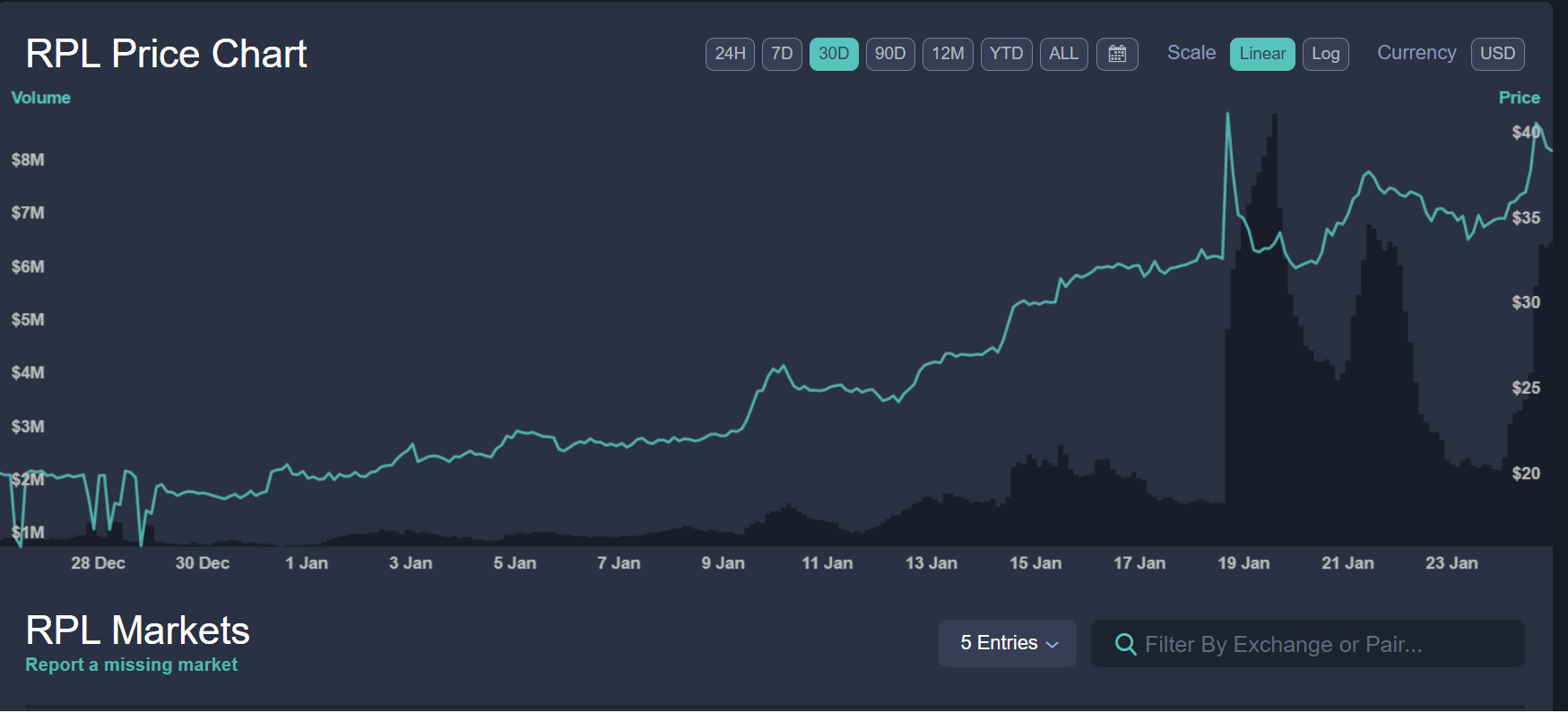With the bullish sentiment returning to the crypto market, I decided to feature a second crypto here as part of my monthly Crypto Watch feature.
Things change rapidly in this space, and the last thing I’d want is for all of us to miss out on
strong gains in quick succession; two to three weeks can make a significant difference here, especially for low to mid-cap crypto assets.
Today, we will look at Rocket Pool and its corresponding digital assets, RPL and rETH.
How does it all work?
Rocket Pool is a decentralised staking service that allows ETH holders to delegate their ETH to help run the network and be rewarded with the rETH token; you are continuously staking ETH for as long as you are holding rETH, which can be readily swapped back into ETH.
This system is classified as liquid staking, which was set up to incentivise ETH staking without locking up Ether, bypassing this process by switching from ETH to rETH and vice-versa (various liquid-staking operators have their native token similar to rETH.
RPL is a collateral token for the protocol, with at least 10% being staked in RPL acting as insurance. Suppose more RPL is assigned as insurance (which can go up to 150% of the staked ETH value). In that case, the node operator also benefits with greater rewards, thus incentivising good behaviour (and penalising any operator with missing ETH when they finish staking).
More information about how this collateral and (dis)incentive structure works is available here.
Fortunately, as part of the Shanghai upgrade, users can withdraw any locked ETH. Even after this fork, if liquid staking were to become redundant, the pools would remain, and I envisage that many people will still opt for liquid tokens, though I could be wrong.
Mining pools are helpful in this space as many retail investors (you and me) can combine tiny amounts of any given crypto to reach a minimum need to operate a stake pool. For Ethereum, this is usually 32 ETH, although Rocket Pool allows node operators to run with as little as 16 ETH.
Liquid staking is just one type of ETH staking service readily available for coin holders, with many who can readily stump up 32 ETH (and have the resources) to go solo or as part of staking as a service (SaaS) by utilising a reputable third party.
Why the significant RPL price increases over the past two weeks?
Besides benefitting from bullish sentiment returning across the market, RPL has also benefitted from an announcement by Metamask, the entity behind the popular non-custodial Ethereum-based wallet — that it will permit Lido and Rocket Pool staking via its wallet.
WEN STAKING?
We are extremely happy to announce that you can now stake ETH with Lido or Rocket Pool through the Portfolio Dapp🎉
🔗https://t.co/HVLvcSDbw6 pic.twitter.com/9VkiU5jlsw
— MetaMask 🦊💙 (@MetaMask) January 13, 2023
This opens up the opportunity for Ethereum holders who use a Trezor (Model T), who can now use this option to stake their ETH; before this Metamask decision, there were no other options (at least nothing publicised).
Moreover, it could run staking pools for assets on other blockchains for greater diversification, as opposed to being solely focused on Ethereum; one of its major competitors, Lido, also offers staking services for other networks such as Solana, Polygon and Polkadot.
Regardless of this, with Ethereum’s price expected to increase in future (provided that continuous improvements are made to the network), coupled with a lot more staking potential on ETH (only 14% staked so far), staking will continue to grow in popularity.
Furthermore, the increase in transactions on the Ethereum network (primarily attributed to NFTs as of late) has helped lead to a deflationary supply, making it even more enticing for ETH holders, encouraging more people to stake and thus indirectly benefiting RPL as well.

RPL price chart and 24-hour trading volume over the past 30 days (Source: LiveCoinWatch).
Concluding thoughts
Overall, Rocket Pool has a promising future, as Proof-of-Stake will most likely remain the consensus algorithm of choice for Ethereum, let alone most crypto assets. Whilst this is not financial advice, allocating at least a small amount of your crypto portfolio to RPL, and even its closest rival, Lido DAO (LDO), to a lesser extent, could be advantageous in the coming years.
As Rocket Pool currently accounts for a small percentage of overall ETH staking pools, it would proportionally benefit a lot more than Lido DAO if it were to continue growing, with the former boasting even greater decentralisation than the latter, not to mention a push for less dominance in the realm of ETH staking pools.
I recommend checking out Staking Rewards to learn more about popular choices and more information about this process.
Disclaimers
None of this is financial advice, and I am not a financial advisor.
The opinions expressed within this piece are my own and might not reflect those behind the Rocket Pool protocol itself. This article has no connection to anyone from the Rocket Pool team.
Please do sufficient research before investing in any crypto assets, staking, NFTs and other product affiliated with this space.
I hold a small amount of RPL, accounting for less than 1% of my total crypto portfolio.
If you enjoyed this article, I recommend following my Medium page for regular reports about crypto assets, blockchain technology, and more. Feel free to check out my publication as well, Crypto Insights AU.
Thanks for your support.

